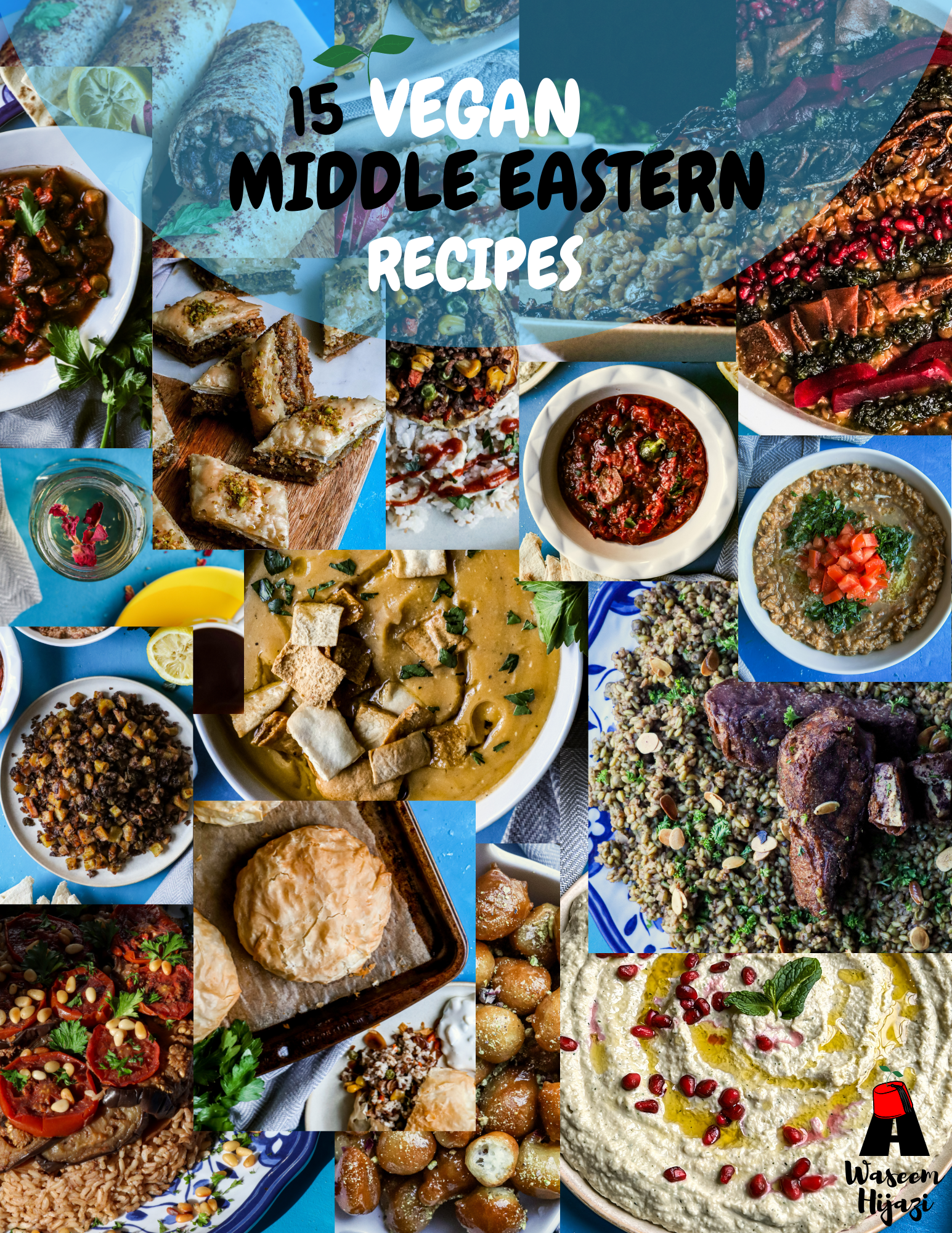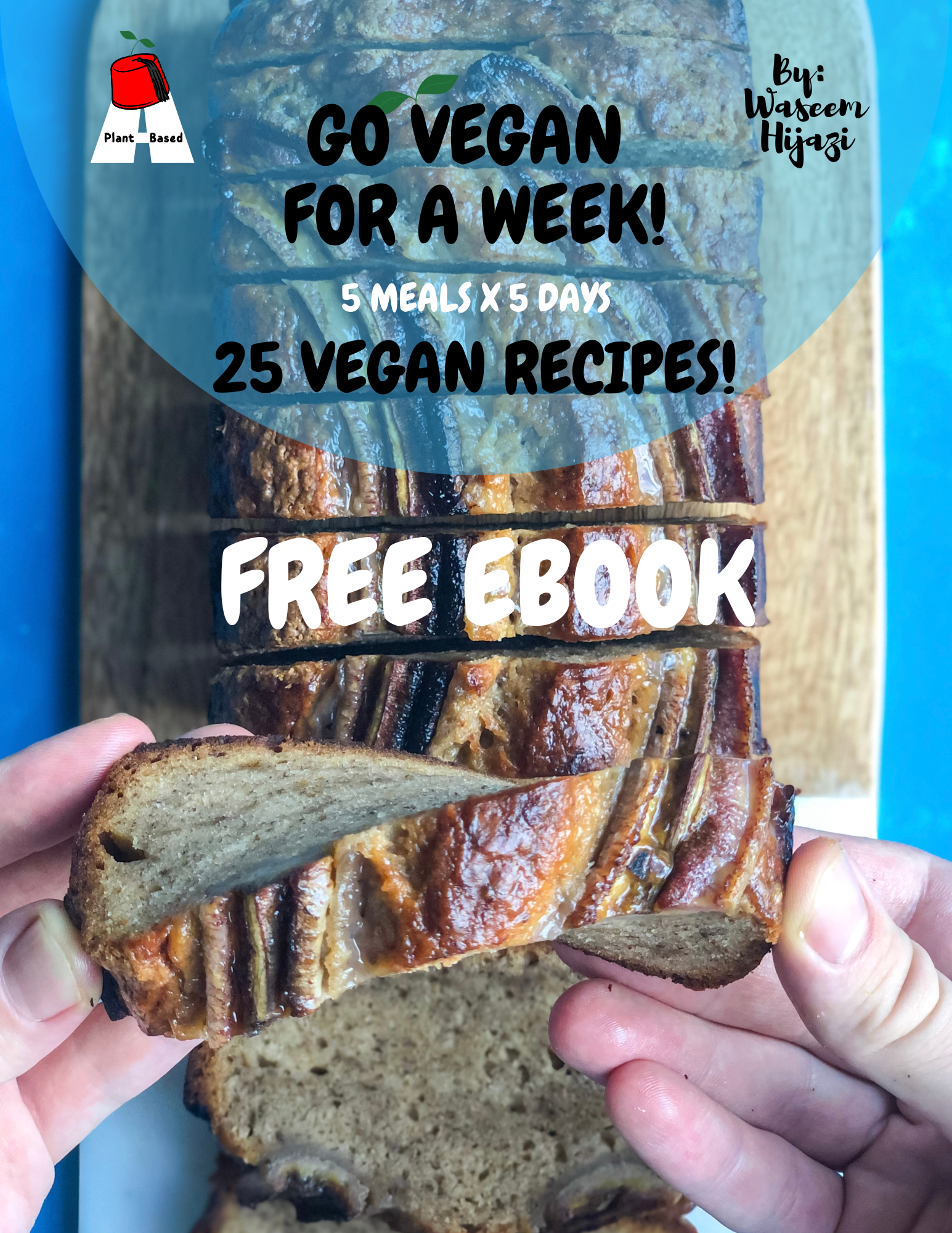Hearty meatless vegan Kibbeh (stuffed meatballs). Bulgur wheat shells with a meaty filling. A classic Arabic appetizer served alongside many other dishes for a lunch Mezze. This high-protein plant based take on the Kibbeh is no different than the original!

About The Recipe
- Made meatless | vegan
- High in protein
- Great appetizer for summer BBQs
What Is Kibbeh?
Pronounced “Kib-beh”, or “Kub-beh”, depending on the region. These stuffed meatballs are a popular side dish that’s often enjoyed over a lunch Mezze, especially during the summer time. The word “Kibbeh” generally refers to the bulgur and meat mixture (known as the casing). Which can be eaten raw, shaped into balls (like a football) and fried, cooked in a yoghurt stew, or pressed into a baking pan, with a layer of minced meat filling. All are beloved variations of Kibbeh in the Arab cuisine.

This vegan Kibbeh (stuffed meatballs) recipe is the plant based version of the traditional fried Kibbeh balls. While made meatless, it’s got the authentic meaty texture on the inside, with the perfect crunchy bite.
Ingredients You Need
- Bulgur: Fine bulgur wheat is needed to make smooth Kibbeh texture. I use brown fine bulgur.
- TVP: Textured Vegetable Protein rehydrated in beefless broth (if available).
- Extra firm tofu: Pressed and drained out of most liquid.
- Onions: Used in making both the casing and the filling
- Pine nuts: Toasted and mixed with the meat filling.

- Kibbeh spices: Also known as Kamouneh spice mix. Can be found at local Middle Eastern grocery store. Or make your own.
- Seven spices: Use store-bought. Or make it at home. If not available, use allspice, along with cumin and ground coriander.
- Sumac: Adds a hint of tang to the filling.
- Ground coriander: Use to adjust the flavours.
- Cumin: Adjust the flavours of the Kamouneh/Kibbeh spices.
- Salt & Black Pepper: to taste

Making The Kibbeh Casing
Using a food processor to help make things easier. Blend the onions until it’s finely minced. Add the soaked bulgur and rehydrated TVP, along with the spices. Pulse a few times to break everything down. Stop and scrape down the sides as needed. If it feels sticky, add a tablespoon of flour and knead it by hand to smoothen out. Empty into a bowl and cover to chill in the fridge for an hour.

Note: It’s important that the mixture of Kibbeh Casing is not to moist/wet. Make sure to drain out excess liquids after soaking the bulgur and rehydrating the TVP.
Preparing The Kibbeh Filling
Break down a block of tofu into crumbs using a food processor (make sure to press and drain it first). Empty into a large pan to cook with more rehydrated TVP, sautéed onions, and similar spices from the Kibbeh Casing. Mix in some toasted pine nuts in the last few minutes of cooking. Remove from heat and cool down completely before stuffing in Kibbeh shells.

Setting Up The Workspace
Before starting, place the chilled Kibbeh Casing and cooled down Kibbeh Filling on the counter. We’ll need a bowl of water and a bowl of oil to help keep the hands damp when shaping the Kibbeh. Depending on the temperature in your kitchen, keep the casing in the fridge while removing a bit at a time to work with.

How To Shape Kibbeh
Take out 2 to 3 tablespoons of the Kibbeh Casing and roll by hand. Repeat until all is finished (keeping the rolled ones chill in the fridge). While holding in the palm of your hand, poke a hole in the centre of the ball. Rotate and continue pressing down to flatten into a thin layer. We want a large half-shell to stuff with the filling.

Add a tablespoon of the filling to the centre of the shell (don’t over-stuff it). While holding tightly in the palm, pinch the top to close and seal it off. Roll by hand to smoothen out, then pinch both ends to make the classic pointy look.

Ways To Cook Kibbeh
Traditionally deep fried in oil. It only takes a couple of minutes to cook the stuffed Kibbeh. They can be baked or air fried instead. Generously cover in oil spray (or oil). Make sure to flip them halfway, and add more oil spray (if needed). You can also freeze these vegan Kibbeh (stuffed meatballs) to cook later.

FAQs
Why is my Kibbeh falling apart when frying?
The Kibbeh casing needs to be smooth but not too sticky. If it’s too wet, it could cause the shell to fall apart when frying. Make sure to completely seal off the Kibbeh when shaping to avoid it from breaking.
Do I need to deep fry the Kibbeh?
The best Kibbeh is deep fried. You can bake or air fry instead, using a generous amount of oil spray (adding more when flipping halfway). While it won’t be the same crunchy texture, the taste will still be there.
Why is the Kibbeh casing too sticky?
The casing is made of soaked bulgur wheat and rehydrated TVP. There’s a lot of moisture in both. It’s important to remove/drain excess liquid before mixing with the remaining ingredients. If it’s still sticky, add a tablespoon of flour (at a time), and knead to combine until nice and smooth.
What type of bulgur is needed for Kibbeh?
Fine bulgur wheat is used in making the Kibbeh casing. Anything larger in texture will not work. For best results, I recommend blending the fine bulgur (after soaking/draining) to break it down even finer.
Kibbeh Recipe
If you have any questions about this recipe, or gave it a try, I’d love to hear your thoughts in the comments section below. Remember to rate the recipe with ⭐️⭐️⭐️⭐️⭐️. This will help us sustain Plant Based Arab.
Snap a photo of your dish, and tag us on Instagram @PlantBasedArab, so we can see and share your remake!
Kibbeh (Stuffed Meatballs)
Course: Lunch, Mezze, SidesCuisine: Arabic, Middle EasternDifficulty: Intermediate24
Kibbeh1
hour30
minutes1
hour30
minutesHearty meatless vegan Kibbeh (stuffed meatballs). Bulgur wheat shells with a meaty filling. A classic Arabic appetizer served alongside many other dishes for a lunch Mezze. This high-protein plant based take on the Kibbeh is no different than the original!
Ingredients
- For The Kibbeh Casing
1 cup brown fine bulgur wheat
1 cup TVP, rehydrated in broth – See Notes (1)
1 medium onion
2 tbsp Kibbeh spices – See Notes (2)
1 tsp seven spices / allspice – See Notes (3)
1/2 tsp salt
1/4 tsp black pepper
- For The Kibbeh Filling
1/2 cup pine nuts, toasted
1 tbsp olive oil (or use broth)
1 medium onion, finely diced
1 cup TVP, rehydrated in broth – See Notes (1)
1 block (350g) extra firm tofu, pressed and drained
1 tbsp Kibbeh spices – See Notes (2)
1 tsp seven spices / allspice – See Notes (3)
1 tsp sumac
1/2 tsp salt
1/4 tsp black pepper
- The Rest
Flour to adjust Kibbeh Casing, if too sticky – See Notes (4)
Water or oil to help shaping, if needed
Vegetable oil for frying (or oil spray to air fry)
Directions
- Making The Casing
- Cover the bulgur with enough *room temperature* water in a large bowl. Soak for 30 minutes, fluff with a fork, and drain excess water (if any).
- Rehydrate the TVP per package instructions, using broth instead of water. Fluff with a fork. Liquid should be mostly absorbed.
- Cut the onion in half and chop off both ends. Add it to a food processor to break down. Add in the remaining ingredients. Pulse a few times to break down, then process on high to combine. Stop, scrape off the sides, and repeat – as needed. See Notes (5)
- Remove the blades and empty into a bowl. The mixture should be somewhat like a paste of meat – easy to form, but not too sticky. Mix in a tablespoon of flour if needed to smoothen out. Cover with food wrap, and refrigerate for at least an hour.
- Preparing The Filling
- Prepare the tofu first. Drain the water from the package. Wrap it in a clean kitchen towel. Squeeze out as much water as possible. Place it in between two plates, with heavy books on top. Or use a tofu press instead. Press it for 15 to 20 minutes. Drain the liquids. Wrap in another clean towel and squeeze to remove excess water. It’s important to remove as much water as possible from the tofu, before using it. Blend in a food processor to break down into crumbs. Set aside for later.
- Rehydrate the TVP per package instructions, using broth instead of water. Set aside for later.
- Add the pine nuts to a medium pan/skillet over medium-high heat. Stir for a few minutes to toast until slightly golden brown. It only takes a couple of minutes, and then they will quickly start to burn. Make sure to stay close to the pan the whole time to avoid burning. Remove into a plate with paper towel and set aside for later.
- Add oil (or broth) to the same pan over medium-high heat. Sauté the diced onions until soft and translucent, about 5 to 7 minutes. Turn down the heat to medium. Stir in the rehydrated TVP and tofu grounds. Add the spices and continue cooking for another 10 to 15 minutes, stirring frequently to avoid burning – until nice an browned, with a chewy texture.
- Stir in the toasted pine nuts from before. Remove from heat, and set aside to cool down before stuffing in the Kibbeh shells.
- Shaping The Kibbeh
- Prepare the workspace. Place two small bowls – one with room temperature water, and the other with a bit of oil. Bring out the bowl of chilled casing from the fridge, and place the bowl of filling next to it. Prepare a sheet pan, lined with parchment paper – to place the stuffed Kibbeh on, while working on the rest.
- Cover both hands with a bit of water to make them slightly damp. Take out a handful of the casing (about 2 tbsp). Squeeze and roll into a ball. If it feels sticky, cover with a tiny drizzle of oil. While holding the ball in the palm of your hand, use the index finger of the other hand to poke a well in the centre. Rotate using the palm, index and thumb. Flatten into a thin half-shell.
- Add a tablespoon of the filling into the shell – don’t overstuff it. While holding tightly in the palm of your hand, close the top and seal it off by pinching the edges together. Gently roll into an oval shape (similar to a football). Pinch the ends to give them the traditional pointy look. Place on sheet pan and continue making the rest. If the temperature in the kitchen is warm, place the stuffed Kibbeh in the fridge to chill for an hour, before cooking.
- Cooking The Kibbeh
- Traditional deep fry – See Notes (6) – Add enough vegetable oil to a large pot (enough to cover the size of the Kibbeh). Bring to 350F (or 175C) and keep at medium heat. It should be hot enough to start bubbling, but not too hot where the Kibbeh will brown too quickly (this might cause it to fall apart). Don’t over-crowd the pot with Kibbeh. Cook for 4 to 5 minutes, carefully flipping halfway. It should be nice and brown, with a slightly hardened shell. Remove using a slotted spoon to drain the oil. Place on paper towel to soak up excess oil.
- Air fry instead – Cover all sides of each Kibbeh with oil spray. Air fry at 375F (or 190C) for 10 to 12 minutes, flipping halfway. Add more oil spray if needed.
- You can also bake in the oven at 400F (or 205C) for 12 to 15 minutes, flipping halfway. Make sure to generously brush the Kibbeh with vegetable oil first (or oil spray).
Notes
- (1) Broth: If available, use beef-less broth to enhance the flavours. Otherwise, vegetable broth will do. Taste test both the Kibbeh casing and filling. Add more spices to both mixtures if needed.
- (2) Kibbeh Spices: Can be found at local Middle Eastern grocery stores. May be known as “Kammouneh Spice Mix”. You can also make your own at home.
- (3) Seven Spices vs Allspice: They’re not the same. If seven spices is not available, you can use a mixture of allspice, cumin, ground coriander, and pepper. Along with a hint of cinnamon, nutmeg, and ground cloves. That’s what makes seven spices.
- (4) Flour For Kibbeh Casing: The casing shouldn’t be too sticky, but loose enough to work with, and close off. If it’s too sticky, add a teaspoon of flour and mix to smoothen out. Repeat until you get the right feel and texture.
- (5) Food Processor: Depending on how powerful your food processor is, you may need to pulse the bulgur and TVP separately (before adding the onion), to break down the texture even further.
- (6) Before Frying: It’s important that the stuffed Kibbeh doesn’t have a lot of moisture. If needed, gently pat it dry with a clean paper towel before frying. Otherwise, it could easily fall apart. I recommend testing one Kibbeh first, and adjust the temperature if needed.
In This Post:












